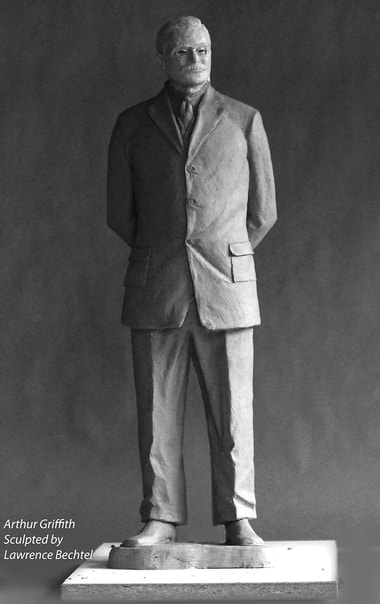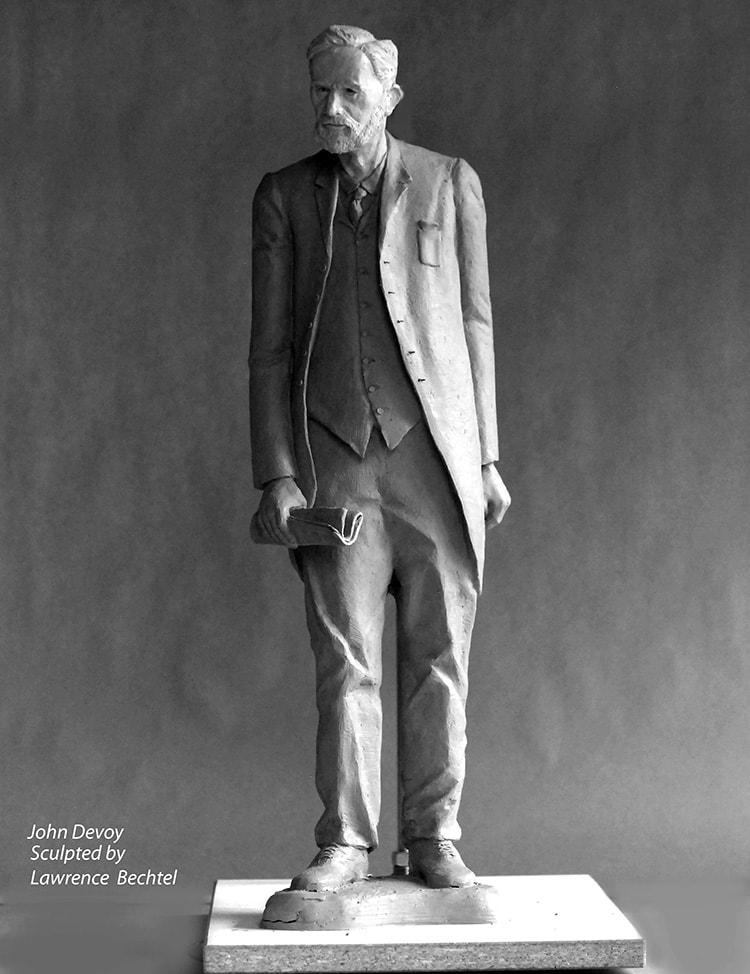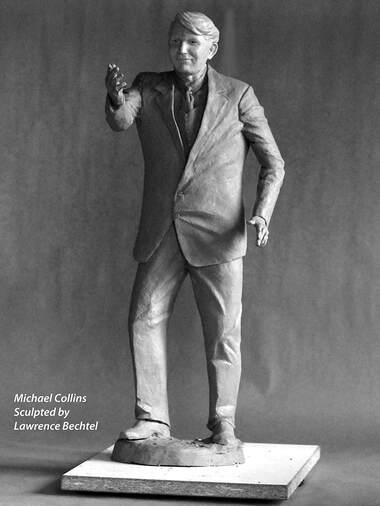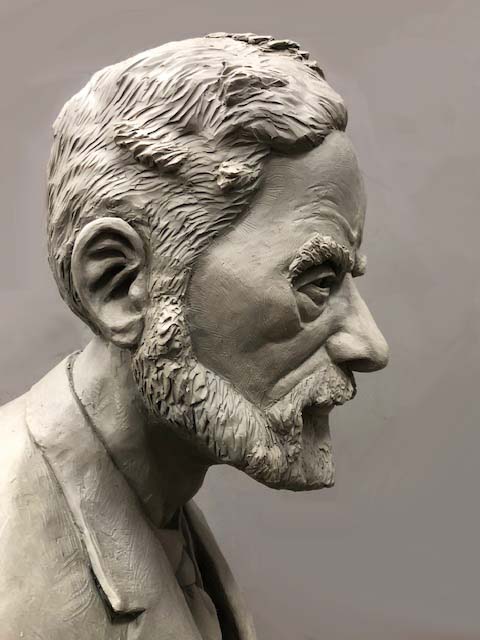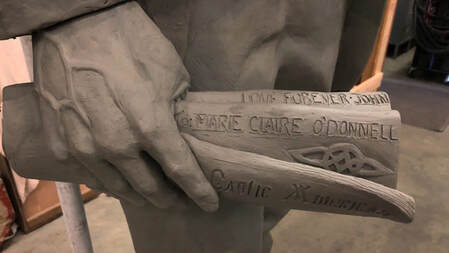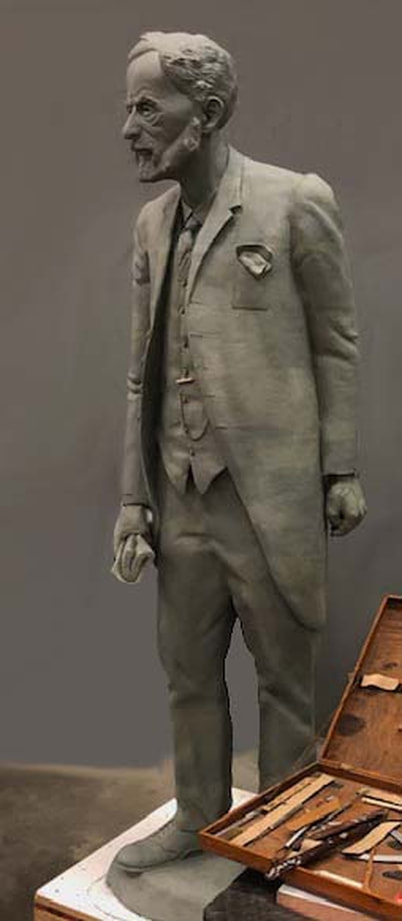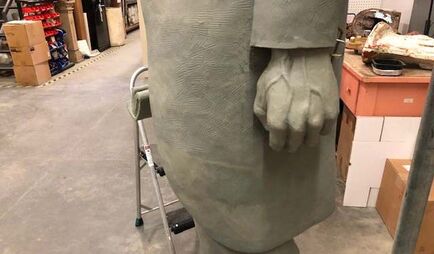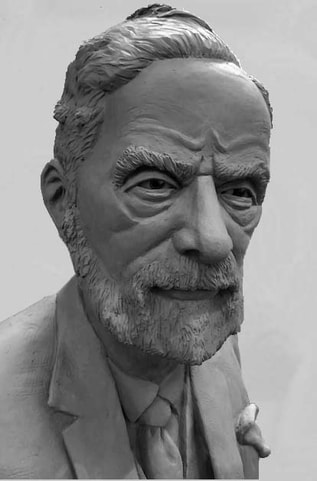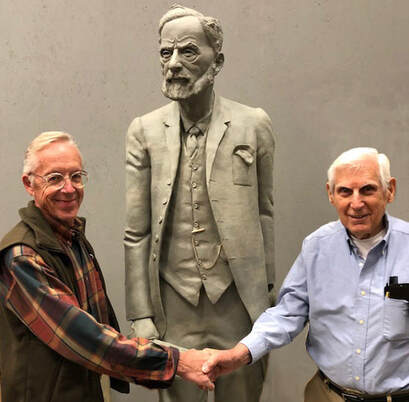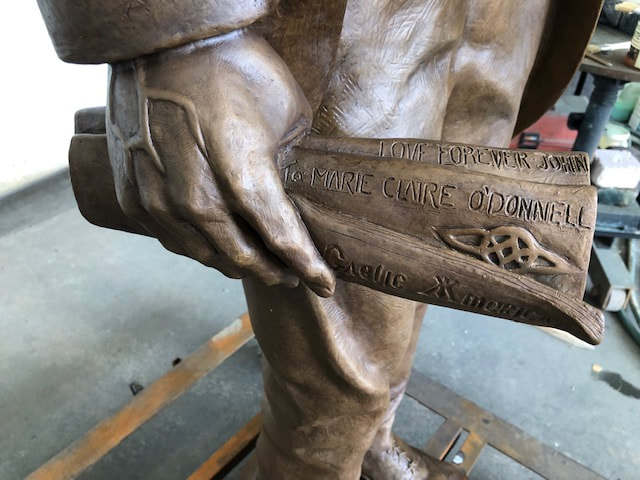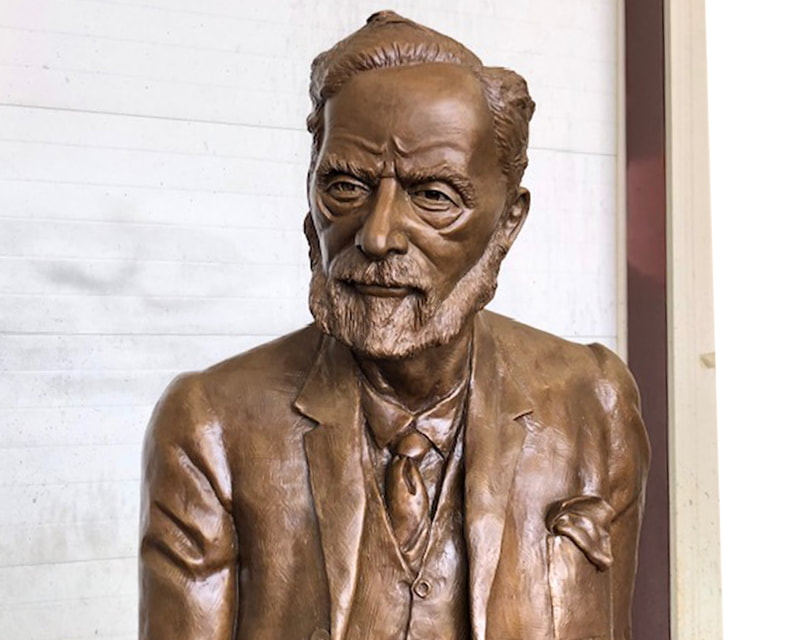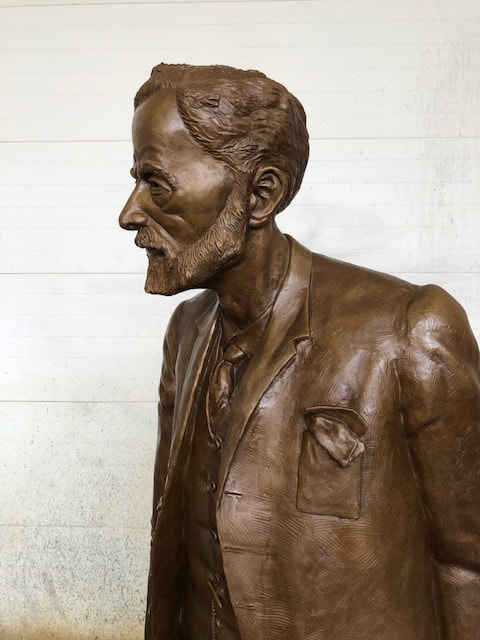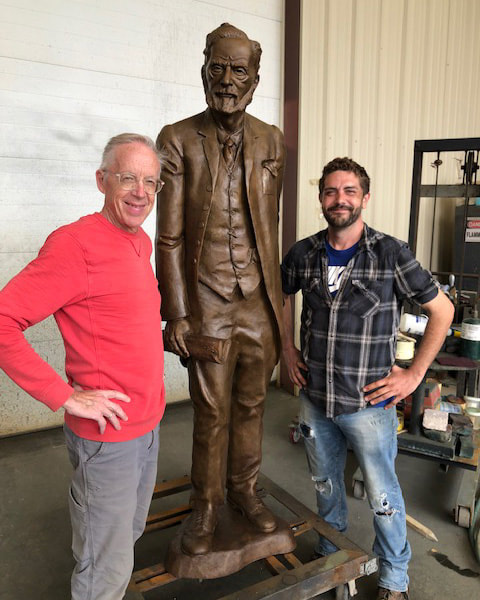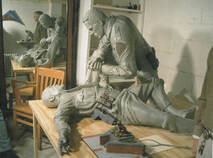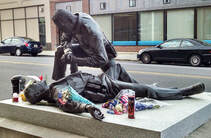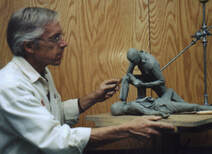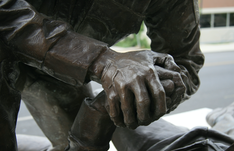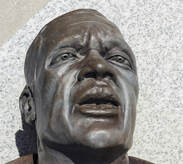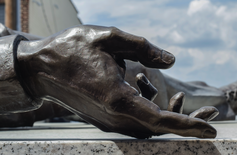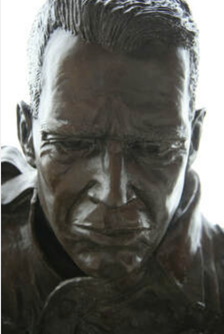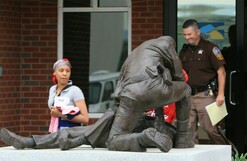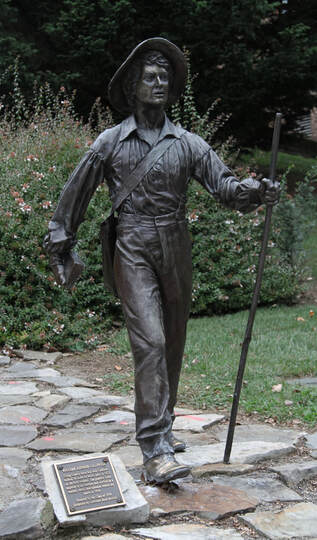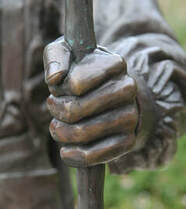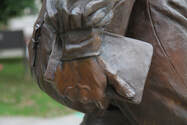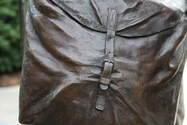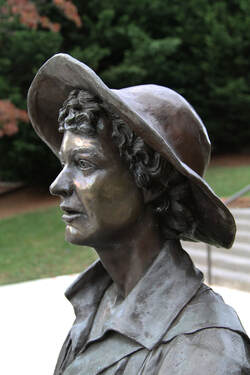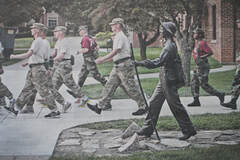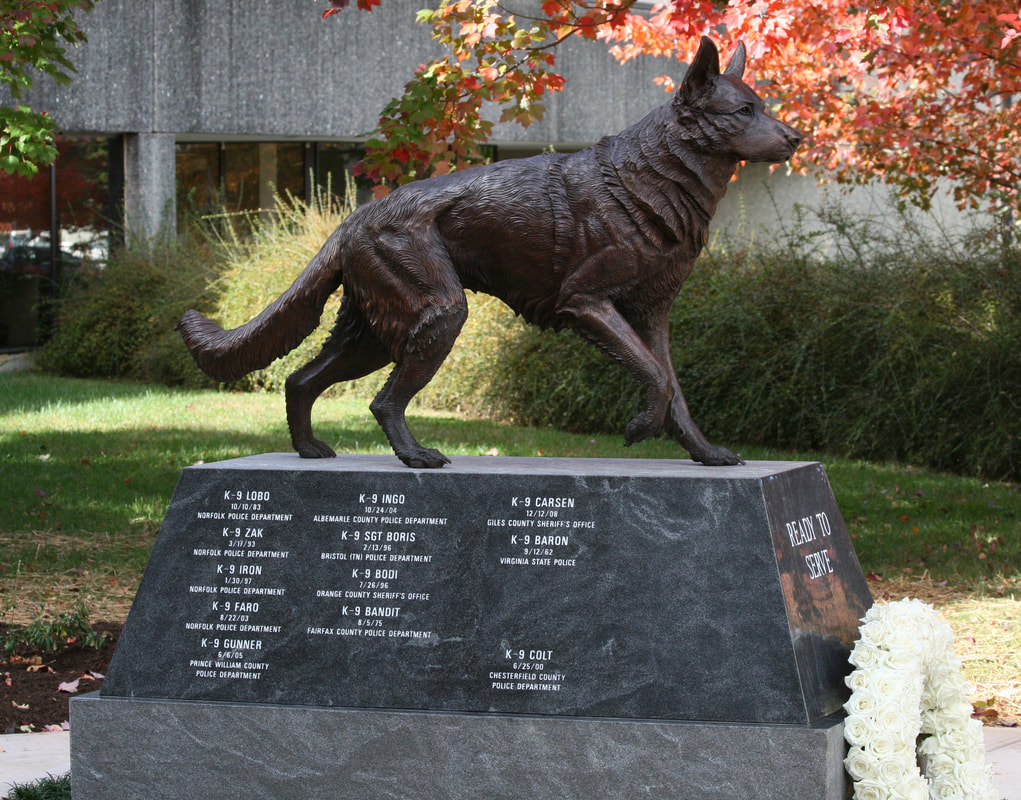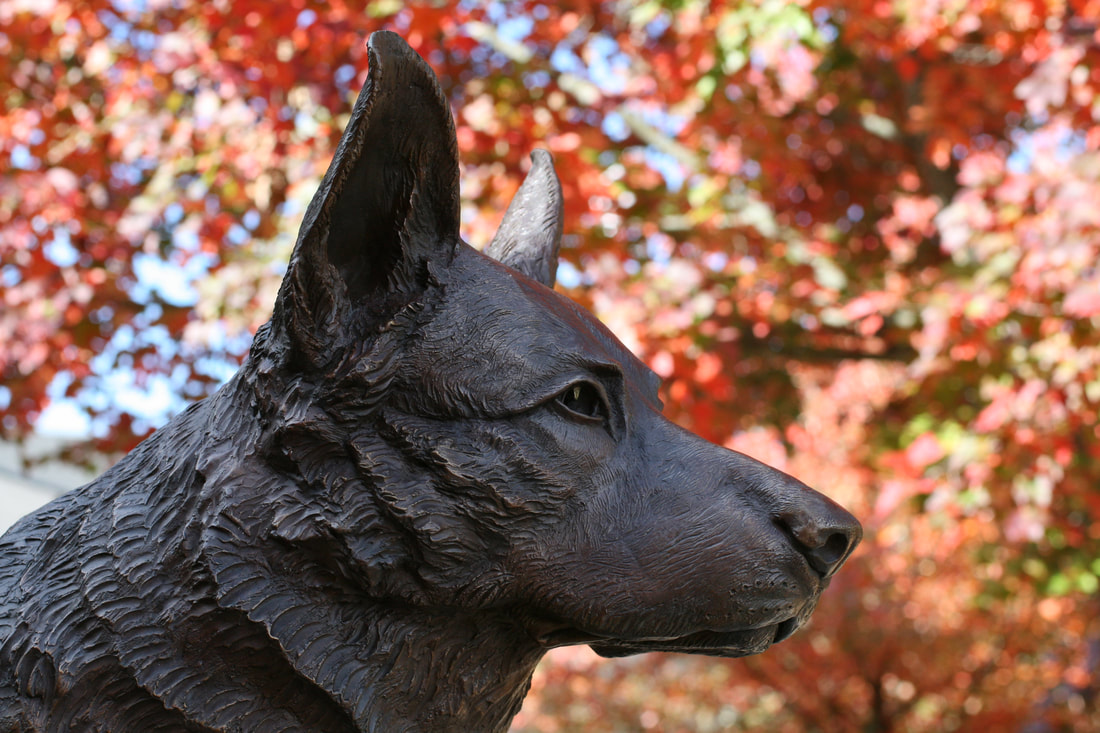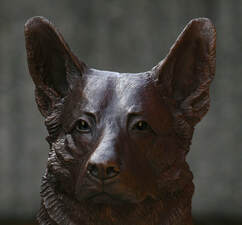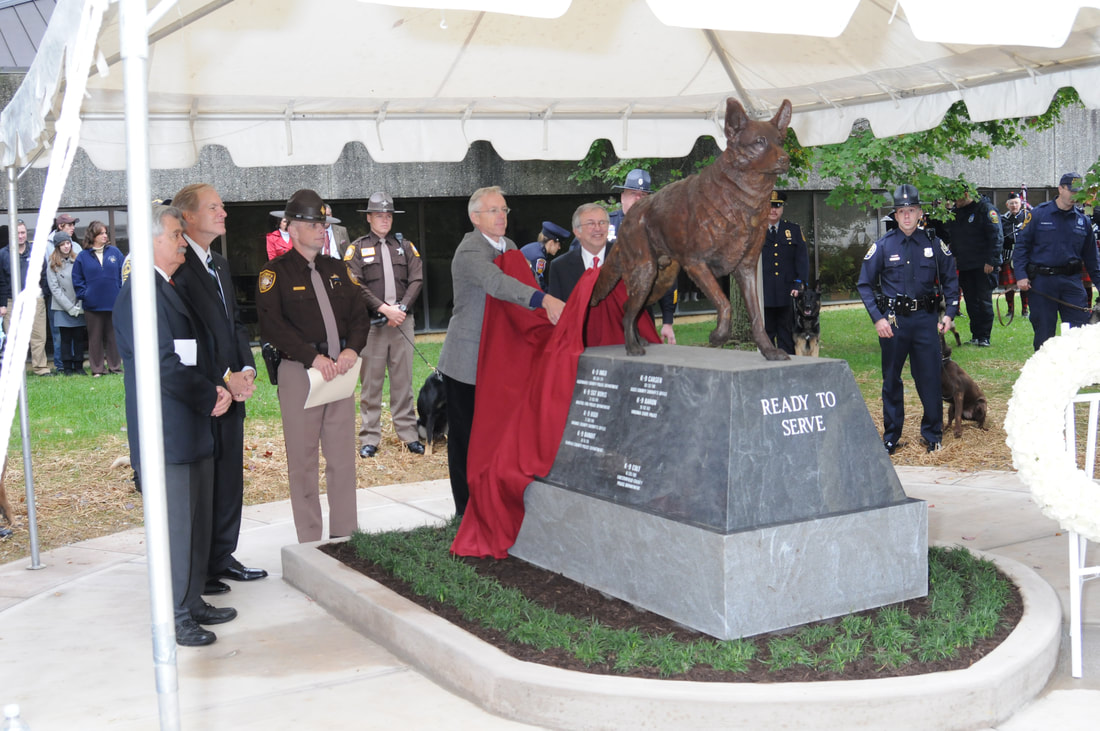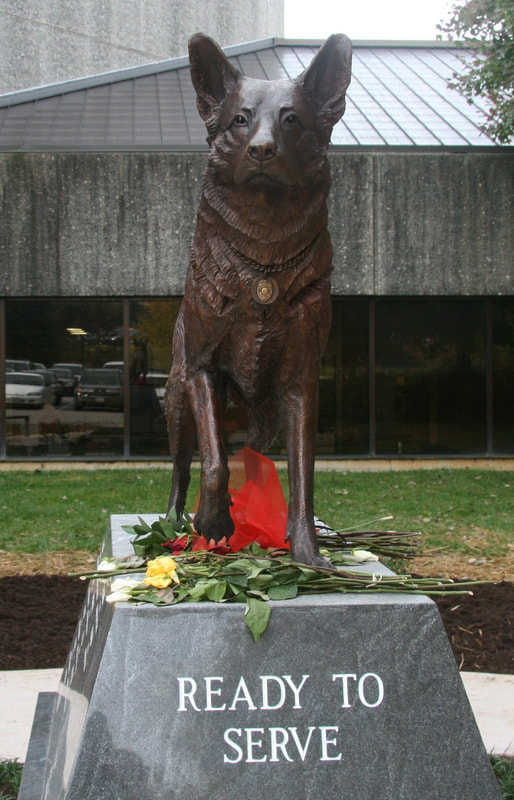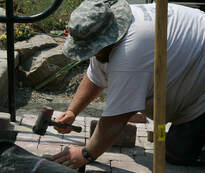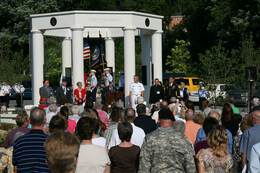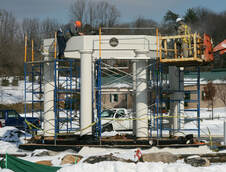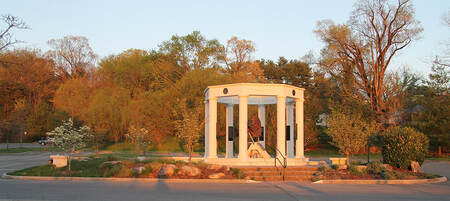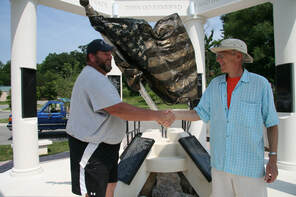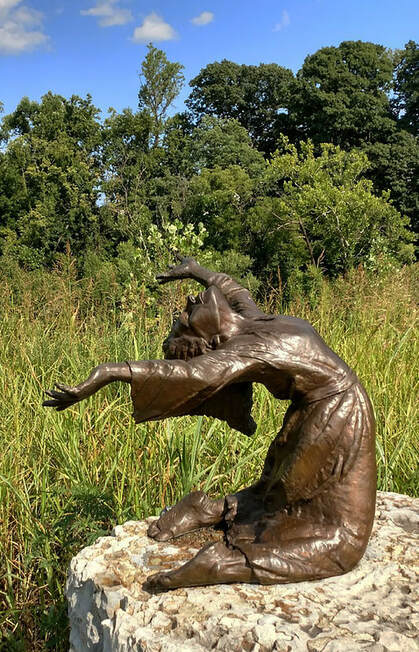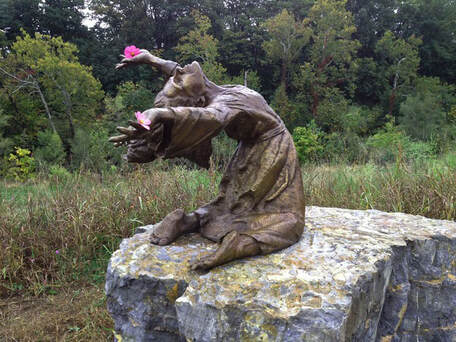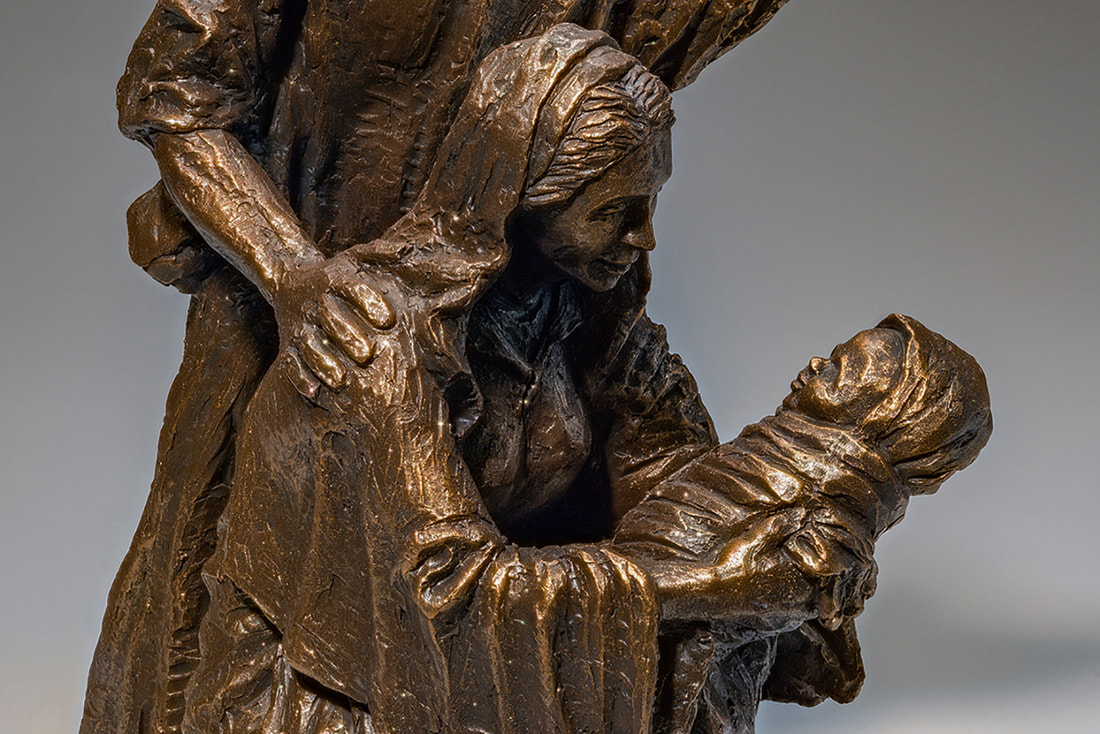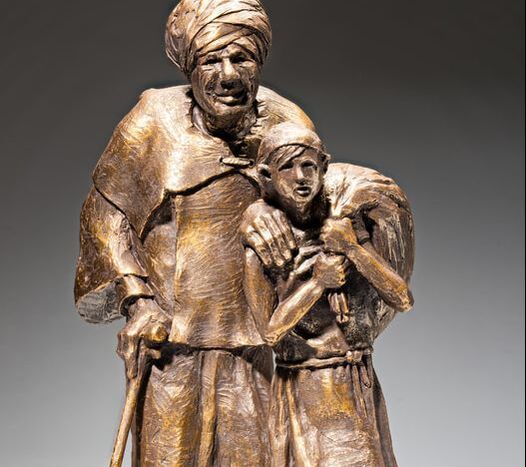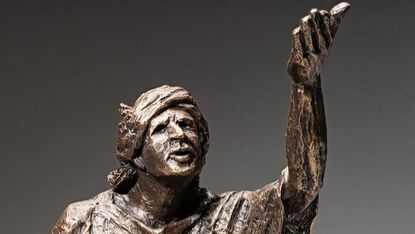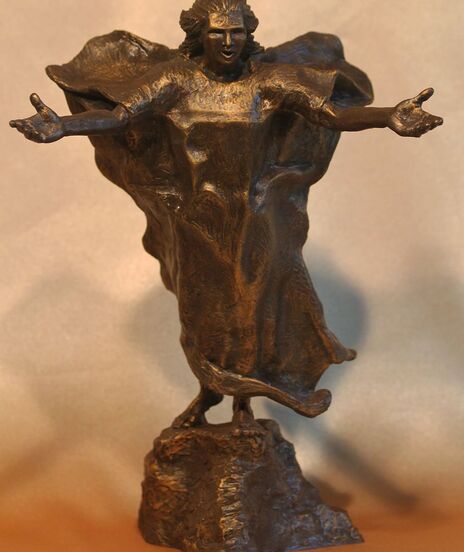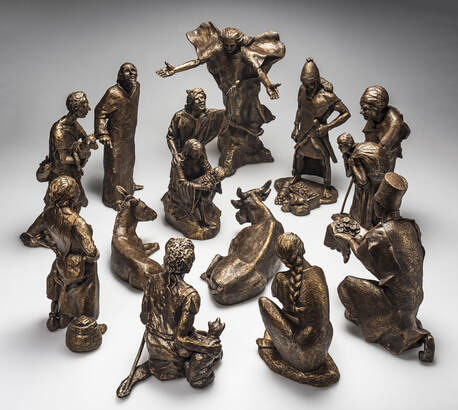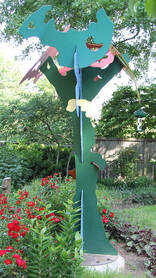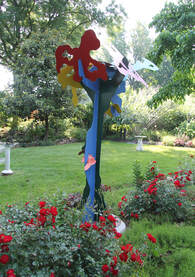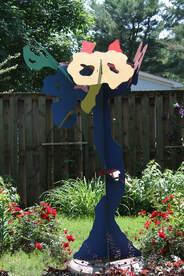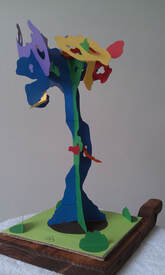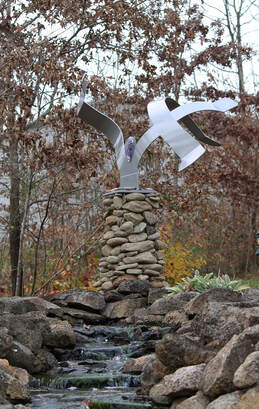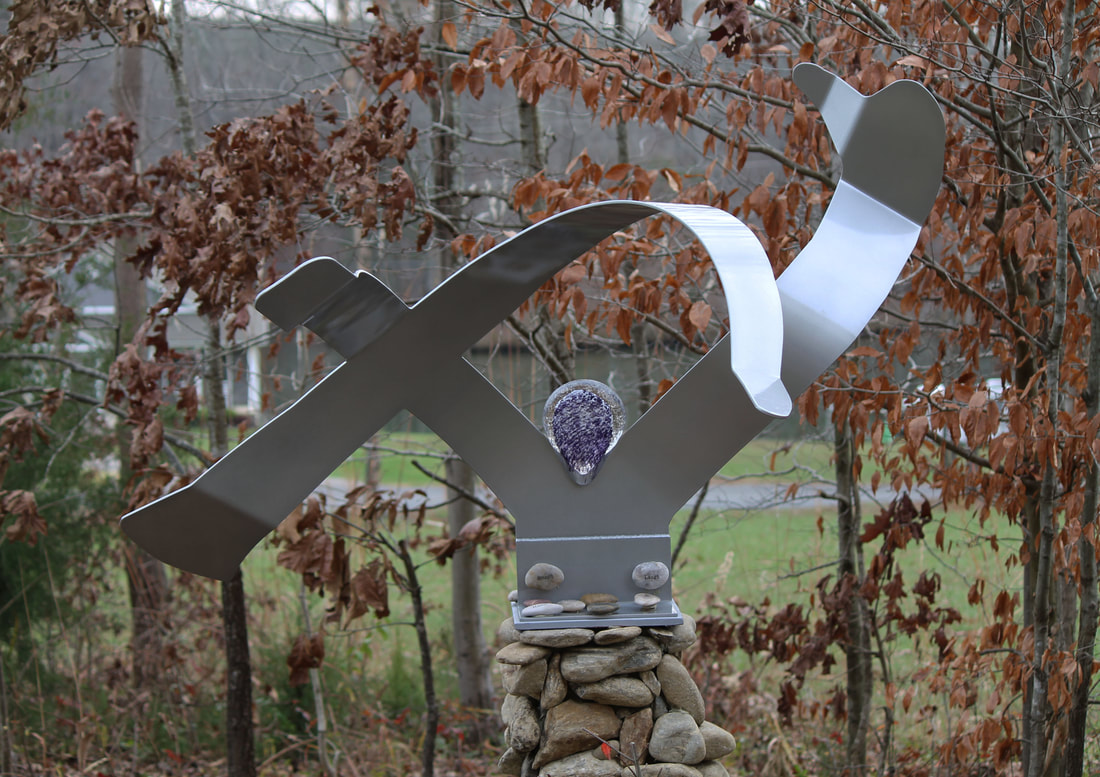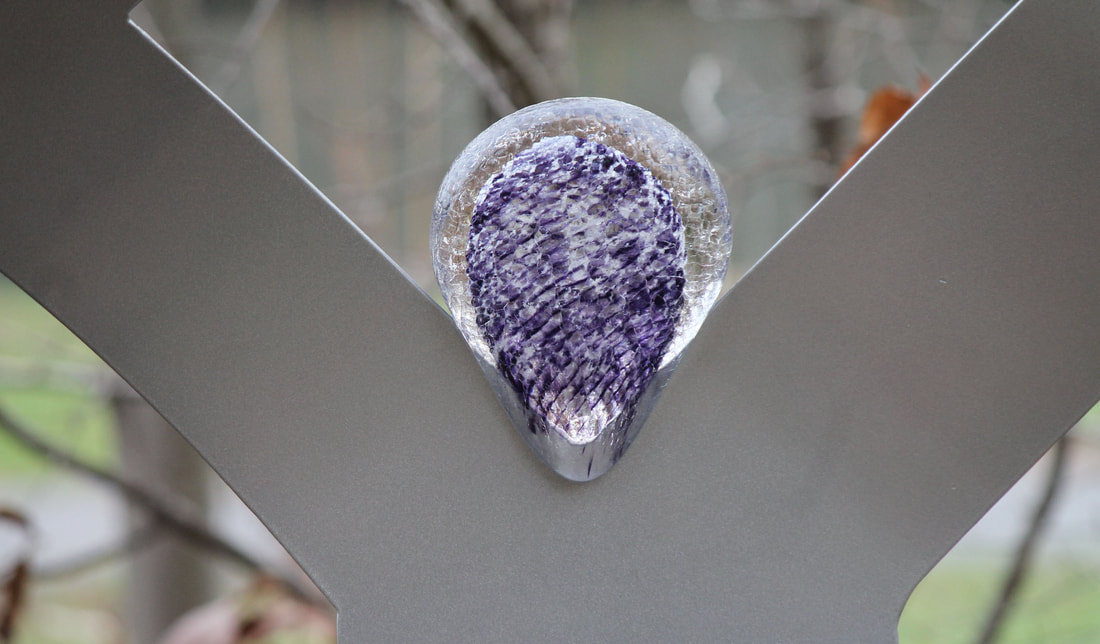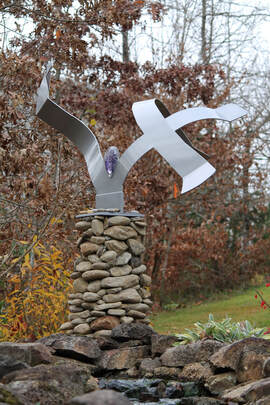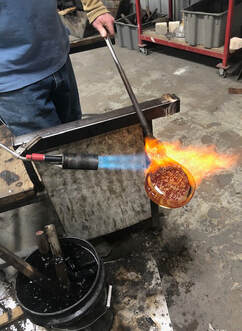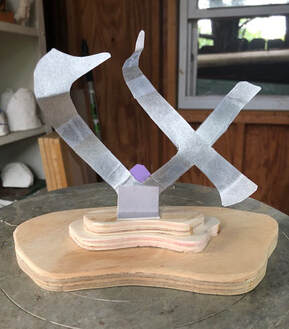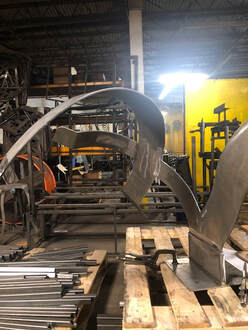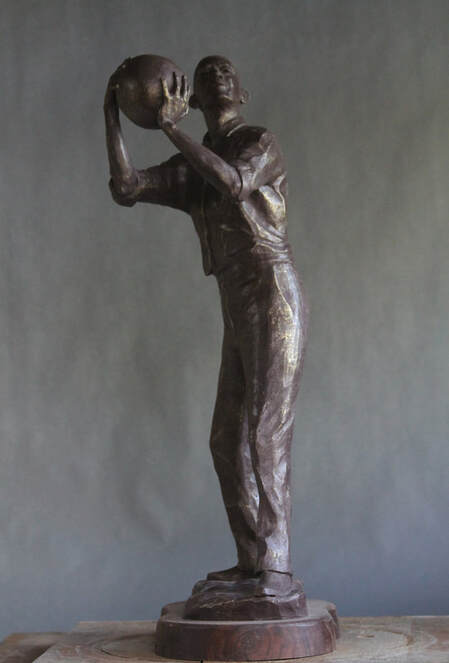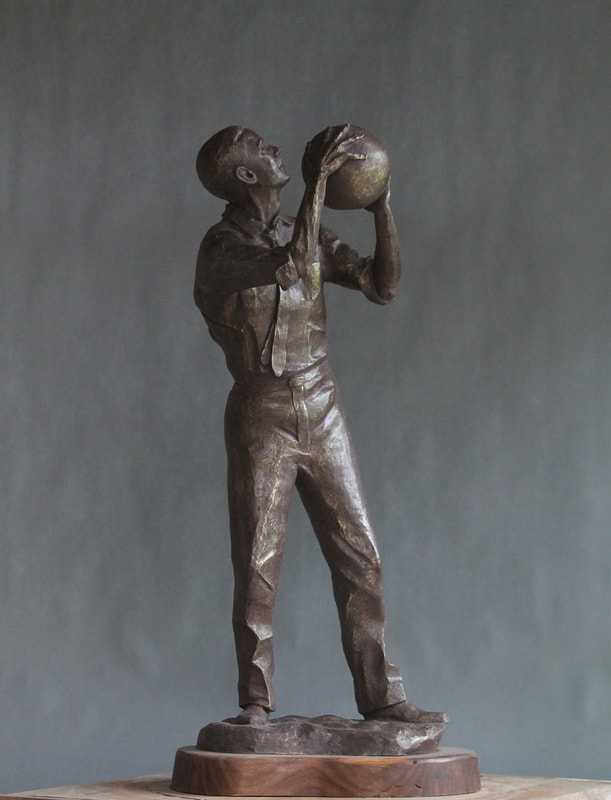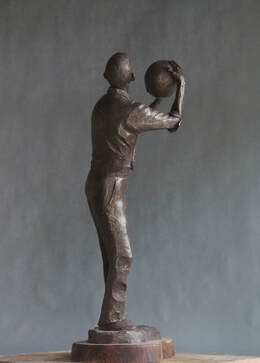Public and Private Commissions
Leaders of the Irish Freedom Movement:
John Devoy, Arthur Grffith, Michael Collins
In August 2020, Melisssa Walker of Carolina Bronze Sculpture, (the foundry I have used for almost thirty years) emailed a question: was I interested in negotiating with a possible client looking for a sculptor to craft bronze statues of three Irish revolutionaries? Absolutely! Negotiations with the client, John Turi, went on via email for six months. In March of 2021 we came to terms. I had by this time done considerable research on the three “revolutionaries,” through books and online. I found scholarly videos on You Tube, and fascinating archival photographic footage from the times.
“The times” in question began with the “Easter Uprising” in Dublin in 1916, and ended, for my purposes at least, with the assassination of Michael Collins in 1922. As these two incidents indicate, it was a tumultuous era. Historical resentment against British rule, which broke out periodically into violence, erupted once again on that fateful Sunday morning. The revolt was quickly suppressed by British troops; principal leaders, including Collins, were imprisoned. Once released, they launched a better organized and more determined resistance. Michael Collins, the popular and charismatic leader of the movement, initiated an effective campaign to assassinate British agents in Ireland, and Irish collaborators. Arthur Griffith, the founder of the Sinn Fein party, was pivotal in developing the constitutional and legal framework for a free Irish Republic. John Devoy, known as the “greatest Sinn Fein of them all,” who had been exiled to the United States for efforts to secure military assistance for the Irish from the Germans during WWI, published “The Gaelic American” newspaper, which sought support and money for the Irish cause.
In March of 2021 I began work on three “maquettes”—each one an accurate, detailed armature/w clay model, 24”(h) of what each full size statue would look like. Maquette modeling at that scale, especially for the head (about 3” high) and face, can be challenging. I completed the three maquettes to Mr. Turi’s satisfaction by June. [INSERT MAQUETTE IMAGES AND FRONT VIEW OF COLLIN’S FACE ]
“The times” in question began with the “Easter Uprising” in Dublin in 1916, and ended, for my purposes at least, with the assassination of Michael Collins in 1922. As these two incidents indicate, it was a tumultuous era. Historical resentment against British rule, which broke out periodically into violence, erupted once again on that fateful Sunday morning. The revolt was quickly suppressed by British troops; principal leaders, including Collins, were imprisoned. Once released, they launched a better organized and more determined resistance. Michael Collins, the popular and charismatic leader of the movement, initiated an effective campaign to assassinate British agents in Ireland, and Irish collaborators. Arthur Griffith, the founder of the Sinn Fein party, was pivotal in developing the constitutional and legal framework for a free Irish Republic. John Devoy, known as the “greatest Sinn Fein of them all,” who had been exiled to the United States for efforts to secure military assistance for the Irish from the Germans during WWI, published “The Gaelic American” newspaper, which sought support and money for the Irish cause.
In March of 2021 I began work on three “maquettes”—each one an accurate, detailed armature/w clay model, 24”(h) of what each full size statue would look like. Maquette modeling at that scale, especially for the head (about 3” high) and face, can be challenging. I completed the three maquettes to Mr. Turi’s satisfaction by June. [INSERT MAQUETTE IMAGES AND FRONT VIEW OF COLLIN’S FACE ]
At this point the foundry stepped in: a 3D digital image was taken from the John Devoy maquette, and this image was used to program a machine which carved out a 6’ replica of the original maquette from “dense polyurethane foam.” I transported this back to my studio where I applied a coat of clay and did the finish sculpting and surface texturing.
The pleasure of sculpture for me, as with fiction writing, is story-building and character development. John Devoy was an especially good subject for this. Though I worked mainly from a single picture of him standing in front of a dilapidated stone cottage, I extrapolated from every clue I could find. For example, he was wearing a coat with tails—long out of fashion. Why? Because, I could imagine, that stone cottage was cold and drafty, and Devoy could barely afford to pay for firewood. The tails kept his back warm. His pants are rumpled; they have not been pressed in months. He has no iron, and no one to do the work for him. He wears a cheap shirt, without a collar pin—more signs of poverty. His kerchief, which is stuffed in a chest pocket, is not merely for show; because of allergies he is constantly blowing his nose. Osteroperosis is developing in his shoulders; his finger knuckles ache from arthritis; his feet hurt from chilblains. A watch chain, threaded through a button hole in his vest, is his lone ostentation: it is connected to his father’s watch, a precious keepsake. Once, as a young man, he nearly married; the girl loved him and would gladly have taken care of him and raised his children. But John Devoy was fearful that domestic life would dull the ardor of his dedication to the cause of Irish freedom. So he turned away from her, even at the cost of loneliness. He knew the stories passed down in his family, how English landowners had driven his grandfather and family out of their home and off their lands. Thus he could not abide the British, a bitterness which penetrated his life in particular ways: he refused to drink an English beer, and could hardly stand the sight of a potato.
You get the idea! Absorbed in sculpture, I get in deep.
You get the idea! Absorbed in sculpture, I get in deep.
Officer Down
During the competition phase of this commission, I visited the site of the proposed sculpture at the entrance to the newly completed Police Department headquarters for Roanoke, Virginia, looking for ideas. I literally bumped into a Lieutenant Sidwell, excused myself, explained my purpose, and asked about the memorial picture of a young officer I'd seen in the lobby. He explained that this officer had been shot and killed during a domestic dispute call, and then he added, to my amazement, that he had been present. Heart pounding, I asked if he would be willing to describe what happened. He nodded, asked me to step into his office, closed the door, and then laid out the whole incident in detail. I knew I had my idea. Once home, I started on a small model, closely based on what Lieutenant Sidwell had told me--and later modeled--and with this and other submission materials, won the commission. It took about eighteen months to get the sculpture completed and installed, and during that time I came to know quite a few officers, from both the Roanoke City and Virginia Tech Police Departments. I went on a night shift "Citizen Ride Along." I was loaned a full police uniform, with protective vest, and all the belt gear, with a "dummy" gun. From all of this I came to understand police work a bit, and recognize that quite often the work involved simply counseling people in awkward, difficult, or traumatic situations.
The officer--David Rickman--who had been killed during the domestic dispute call, had been a rookie. When Lieutenant Sidwell, the commanding officer on duty that evening, heard the "Officer Down" call go out, he rushed to the scene, "clocked" a big drunk man coming out the front door, pulled Officer Rickman to safety behind a bush, opened his shirt and loosened his vest--and saw that the young man had been shot through the lungs and heart. Just as you see in the sculpture, Lieutenant Sidwell held the dying officer's hand in both of his. Those linked hands are for me the focal point and emotional center of the whole sculpture.
The officer--David Rickman--who had been killed during the domestic dispute call, had been a rookie. When Lieutenant Sidwell, the commanding officer on duty that evening, heard the "Officer Down" call go out, he rushed to the scene, "clocked" a big drunk man coming out the front door, pulled Officer Rickman to safety behind a bush, opened his shirt and loosened his vest--and saw that the young man had been shot through the lungs and heart. Just as you see in the sculpture, Lieutenant Sidwell held the dying officer's hand in both of his. Those linked hands are for me the focal point and emotional center of the whole sculpture.
Addison Caldwell (Walking Toward the Light)
In the fall of 1872, Addison ("Add" as he was known to family and friends) and his brother Milton hiked twenty-eight miles over the mountains from their home place on Sinking Creek in Giles County to attend the newly established "Virginia Agricultural and Mechanical College," in the little town of Blacksburg. According to family legend, Addison, being faster, arrived first, and was thus awarded a scholarship and his place in the history of what became Virginia Polytechnic Institute and State University.
The story has the quality of folklore and greatly appealed to me, so I made a small model, prepared a proposal, and pitched the idea to the Office of University Architect. Lo and behold, several months later, through a different channel, I received word that the Class of '56 had chosen to fund my proposal. I hired a young man from the Theater Arts Department to model as Addison, consulted with a local Civil War re-enactor about Add's clothing and accouterments, hired a tailor to make the fitted costume, and even packed the haversack with items I thought Addison might have carried with him: a change of clothes, extra pair of socks, and a sandwich. Best of all, I discovered that the university's Special Collections kept a small trove of Addison's possessions, including a Bible, inscribed to him by his mother, with a listing of verses, all warning of the dangers of "strong drink"! Naturally, I had to be sure that Addison had that Bible firmly in hand.
The original location of the sculpture, with a small rise in the background, enabled Landscape Architect Matt Gart and I to design a setting which simulated Addison's pathway down from the mountain; a restless soul, he was later moved to a location near the flagpole in the Upper Quad, and finally to a more prominent location mounting the long set of steps from The Mall up to historic Lane Hall. Every autumn, freshmen cadets in the Virginia Tech Corp of Cadets retrace the first half of Addison's trek, from Sinking Creek to Caldwell Fields, and then complete his trek in the spring, from Caldwell Fields to Blacksburg. I participated in the fall hike, while the sculpture was being cast, and thoroughly enjoyed the experience. It was an honor and a delight to march along with such fine, idealistic young men and women, marching in loose, happy order behind their regimental flags. Bless them all, and if they must sacrifice their lives, may it be for a purpose worthy of them and of our country!
The story has the quality of folklore and greatly appealed to me, so I made a small model, prepared a proposal, and pitched the idea to the Office of University Architect. Lo and behold, several months later, through a different channel, I received word that the Class of '56 had chosen to fund my proposal. I hired a young man from the Theater Arts Department to model as Addison, consulted with a local Civil War re-enactor about Add's clothing and accouterments, hired a tailor to make the fitted costume, and even packed the haversack with items I thought Addison might have carried with him: a change of clothes, extra pair of socks, and a sandwich. Best of all, I discovered that the university's Special Collections kept a small trove of Addison's possessions, including a Bible, inscribed to him by his mother, with a listing of verses, all warning of the dangers of "strong drink"! Naturally, I had to be sure that Addison had that Bible firmly in hand.
The original location of the sculpture, with a small rise in the background, enabled Landscape Architect Matt Gart and I to design a setting which simulated Addison's pathway down from the mountain; a restless soul, he was later moved to a location near the flagpole in the Upper Quad, and finally to a more prominent location mounting the long set of steps from The Mall up to historic Lane Hall. Every autumn, freshmen cadets in the Virginia Tech Corp of Cadets retrace the first half of Addison's trek, from Sinking Creek to Caldwell Fields, and then complete his trek in the spring, from Caldwell Fields to Blacksburg. I participated in the fall hike, while the sculpture was being cast, and thoroughly enjoyed the experience. It was an honor and a delight to march along with such fine, idealistic young men and women, marching in loose, happy order behind their regimental flags. Bless them all, and if they must sacrifice their lives, may it be for a purpose worthy of them and of our country!
That I May Serve (Virginia Police Dog Sculpture)
For several years, the Police Work Dog Association (VPWDA) had sought to raise funds for a memorial to all police dogs killed in the line of duty in Virginia. After I had submitted a cost estimate, as requested by an administrator in the Virginia-Maryland Regional College of Veterinary Medicine, at Virginia Tech (VMRCVM), where the memorial was to be sited, an anonymous donor stepped forward and provided funding and I could begin work. With permission from K9 Officer John Hoover, I was able to attend obedience/training sessions at various locations, including Smith Mountain Lake and Virginia Tech's "Smart Road," and watch officers and their animals in action. I learned what a commitment K-9 work requires: the dog becomes a true partner and a 24/7 responsibility. A real bond develops, emotional and affectionate, because the dog, on command, will without hesitation put its own life in danger, sparing the officer's life. It is also a bond specific to his or her dog--not just anybody can go up and touch or pet one of these animals--or get anywhere near one, as I soon learned. Fortunately, I met Keith Weaver, a K-9 Officer with the Virginia Tech Police Department, and his big, handsome German Shepherd, Boris. Keith had Boris so well trained that he would stand absolutely motionless as I took numerous anatomical measurements, right down to the distance between his pupils and the height of his ears, and I could run my hands along his body and down his legs to feel his musculature. I had further assistance from Pat Arnold at VMRCVM, who provided me with a canine cadaver. The unveiling of the memorial was quite an event, with many K9 officers and dogs present, and a bagpipe band!
Vinton-Roanoke County Veterans Memorial
This project, dedicated in 2011, was a long pull, with an outstanding result. About five years earlier, I had drawn up conceptual drawings, in answer to an invitation for proposals from the Town of Vinton, Virginia. These concept drawings were deeply influenced by the works of Isamu Nogochi, especially after I had visited his museum in Queens NY. Noguchi often included water in both his public and private commissions, so I decided to include a fountain in my concept. Lacking the expertise to install one, I searched for a partner and John E. Kirtley, Jr., owner at the time of "Hillbilly Pond Works" of Roanoke responded. He loved what I had in mind, and saw how it could be improved. Realizing then that a landscaping expert would be very helpful, I invited Mary Babcock to join up, and between the three of us we refined the concept, I prepared the submission documents, John built a large and detailed model--and we won the commission.Though initially the memorial was intended to honor only veterans from Vinton, eventually it was expanded to include veterans from Roanoke County. The process of finalizing the plan, developing a timeline, working with vendors, and hammering out a budget, took months and required patience and dedication from everyone involved. Though I drew up the contract, it was John who signed it and supervised construction--not just supervised, but worked at the job personally, from erection of the columns for the central structure to the cutting and placement of the walkway bricks. In the compressed space of approximately 3500 sq.ft., the completed memorial conveyed a bundle of both national and individual meanings using a variety of materials. Inscribed on the lintels is a message I devised, based loosely on the pattern of phrases used in the roadside Burma Shave ads (if you remember those): 'Here Pause Awhile / And Bless Their Sleep / Who Fell in War / To Save Our Peace / Then Go Renewed / And Build the Lives / They Lost for You/In God We Trust.'
Calling the Powers
|
This sculpture is located in a linear field of tall grasses and wildflowers, beside the Roanoke River, in Vic Thomas Park, part of the Roanoke Greenway system. It was purchased by the Roanoke Arts Council and installed in an area dedicated to the memory of Roanoke activist and 'influencer,' Ann Masters. No sculpture I've ever done is more beautifully suited to its location, nor so loved. The boulder was donated by Rockydale Quarries Corporation. I picture this powerful woman striding boldly to a windy height, where she falls upon her knees, flings wide her arms, and 'calls the powers.' Amen!
|
The Nativity
Lawrence Bechtel was commissioned by the Blacksburg Presbyterian Church, in Blacksburg, Virginia, to create an original set of figurative sculptures based upon the Biblical stories of Christ's nativity. The commission took three years to complete. Bechtel based his creations on the Gospel accounts from Matthew and Luke, certain extra-Biblical accounts, and with inspiration taken from many images of other Nativity depictions by painters and sculptors going back to Roman times. Bechtel created each figure in clay, employed Mountain View Studio in Greenville TN, to cast each piece in a durable resin, and then finished out the figures in his studio. The figures range in height from about 8" (Ram and his dog Pup) to about 15"(Behold!) They can be purchased individually, as groups (ie, the Wise Men only), or as the complete set of twelve. Please contact Lawrence for pricing information.
Color Tree
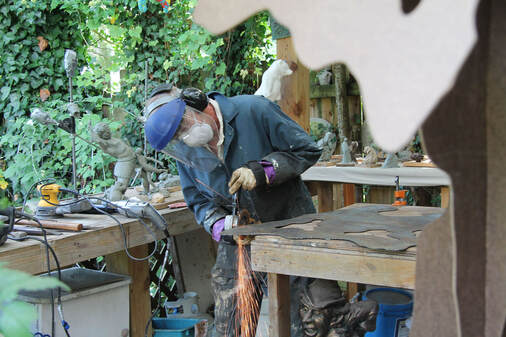
My brother-in-law, John Pinkerton, commissioned me to do a sculpture for his garden, for guidance saying only that he did not want a figurative piece and liked the work of the Spanish architect, Antoni Guadi. With those parameters, I began playing around with lots of different ideas, advancing a few of these ideas with additional sketches. Somehow or other I stumbled into "Sketch up," and in the mix between knowing and not knowing how to work the program I gradually came up with the design which I called "Color Tree." From this design I made a small model from colored construction paper, which John approved. Then began the difficult process of translating an 8" paper model into the 8' finished steel work. Eric Collins was able to cut out the small parts with his improvised laser cutter, after which I spent many hours grinding away rough edges. B&M sheet metal in Roanoke VA, cut out the tree-trunk pieces, and the base. Then I painted all the parts--two coats of primer and two coats of color--and retired Virginia Tech Sculpture Professor patiently and expertly welded everything together. It took a group of friends, in a re-do of Iwo Jima, to set up Color Tree on its foundation and bolt it in place. John and Kathy were both very pleased. Bodacious!
Strength, Fallen, Soars
This work, which I entitled "Strength, fallen, soars," was commissioned by Karen DeBord of Bedford Landings, who wished to honor her deceased daughter, Whitney. She asked that I incorporate two elements in the sculpture: strength and movement. After experimenting with various small paper models, I settled upon using a rune representing strength--a rune which Whitney had tattooed on her shoulder--turned this upside down, and bent the "wings" into shapes which suggested the movements of a bird flying upwards or soaring. With Karen's approval of the model, I contracted with Twist & Turns of Roanoke to have the model enlarged to a suitable size, laser-cut from 1/4" steel, bent and crimped, and powder coated a bright silver, because silver was one of Whitney's favorite colors. I then worked with Tim Burke of Daley Glassworks in Floyd to design and fabricate a purple glass funerary urn for some of Whitney's ashes. Because Whitney's other favorite color was purple, I asked Tim to include that color in his making of the glass urn. Karen's husband Jack designed and built the cairn-like structure which serves nicely to elevate the sculpture, and connects the whole structure with the rock-lined waterfall. Altogether, this was a fine project, richly symbolic, and collaborative in many ways. We had hoped to have the work finished and installed by Thanksgiving, and indeed Jack managed to get it bolted to the cairn a mere four hours before members of the client's family began arriving on Wednesday, November 25th! I extend my thanks to Dorsey Taylor of LinDor Arts, in Roanoke, for putting me in touch Karen.

